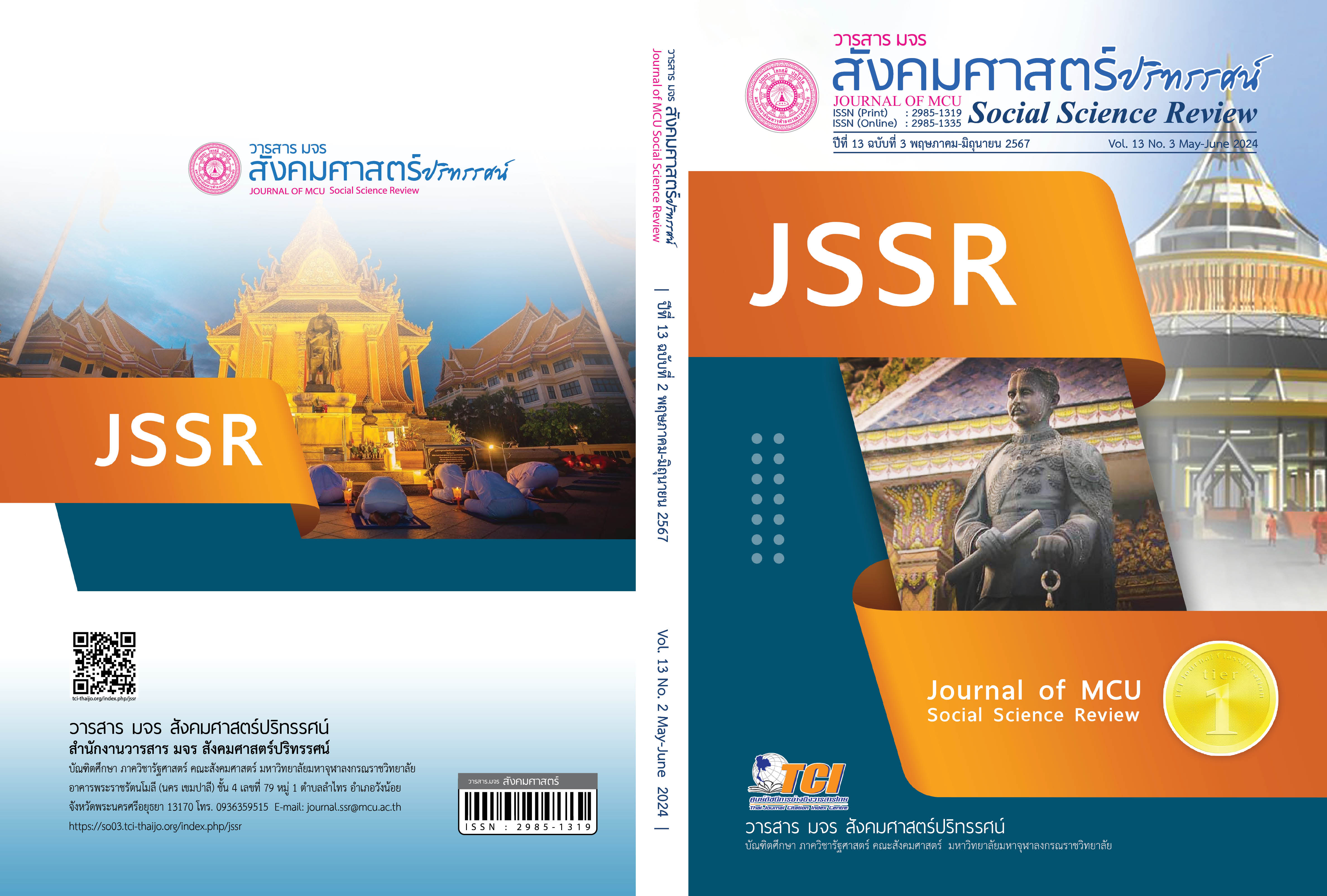การพัฒนารูปแบบการเผยแผ่พระพุทธศาสนาของหน่วยอบรมประชาชนประจำตำบล (อ.ป.ต.) ตำบลหนองน้ำใส อำเภอภาชี จังหวัดพระนครศรีอยุธยา
คำสำคัญ:
การพัฒนา, รูปแบบการเผยแผ่, การเผยแผ่พระพุทธศาสนาบทคัดย่อ
บทความวิจัยนี้มีวัตถุประสงค์ 1. ศึกษาสภาพทั่วไป 2. ศึกษาการขับเคลื่อน และ 3. แนวทางพัฒนารูปแบบการเผยแผ่พระพุทธศาสนาของหน่วยอบรมประชาชนประจำตำบล ตำบลหนองน้ำใส อำเภอภาชี จังหวัดพระนครศรีอยุธยา ระเบียบวิธีวิจัยเป็นการวิจัยแบบผสานวิธี การวิจัยเชิงคุณภาพเก็บข้อมูลจากผู้ให้ข้อมูลสำคัญ จำนวน 24 รูปหรือคน และการวิจัยเชิงปริมาณ จากกลุ่มตัวอย่าง 359 รูปหรือคน วิเคราะห์ข้อมูลด้วยสถิติพรรณนา
ผลการวิจัยพบว่า 1. ผู้ให้ข้อมูลส่วนใหญ่เป็นเพศหญิง ร้อยละ 90.50 ช่วงอายุ 51-59 ปี ร้อยละ 49.50 ใช้ชีวิตคู่ครั้งแรกช่วงอายุ 20-30 ปี ร้อยละ 59.00 สถานะสมรส ร้อยละ 92.38 ใช้คู่ชีวิต 1 ครั้ง ร้อยละ 92.38 ระดับการศึกษาต่ำกว่าระดับระดับมัธยมศึกษา ร้อยละ 60.95 ประกอบอาชีพเกษตรกร ร้อยละ 80.00 รายได้ต่ำกว่า 5,000 บาท ร้อยละ 64.76 ใช้แอพพลิเคชั่นไลน์ ร้อยละ 73.33 มีและไม่มีทะเบียนสมรสจำนวนเท่า ๆ กัน 2. ระดับความเสี่ยงต่อความรุนแรงภาพรวมในครอบครัวมีค่าเฉลี่ย เท่ากับ 1.90 (0.58) ระดับน้อย 3. ลักษณะส่วนบุคคลมีระดับความเสี่ยงต่อความรุนแรงในครอบครัวที่แตกต่างกันอย่างมีนัยสำคัญทางสถิติ (P Value< 0.05) ได้แก่ ช่วงอายุกับด้านเศรษฐกิจ ระดับการศึกษากับด้านสังคมและด้านเศรษฐกิจ สถานะภาพสมรสกับด้านสังคมและการมีทะเบียนสมรสกับด้านเศรษฐกิจ
เอกสารอ้างอิง
พระธงชัย ธมฺมวโร และคณะ. (2563). การขับเคลื่อนการปฏิรูปกิจการพระพุทธศาสนาด้านการเผยแผ่พระพุทธศาสนาของพระสงฆ์จังหวัดชัยนาท. วารสาร มจร สังคมศาสตร์ปริทรรศน์, 9(2), 179-192.
พระมหากฤษฎา กิตฺติโสภโณ. (2561). เทคนิคการใช้สถิติเพื่อการวิจัย. พระนครศรีอยุธยา: มหาวิทยาลัยมหาจุฬาลงกรณราชวิทยาลัย.
พระศรีพัชโรดม (ลักษณะ กิตฺติญาโณ) และชยุต ภวภานันท์กุล. (2560). รูปแบบการเผยแผ่พระพุทธศาสนาของพระสงฆ์ในสังคมไทย. วารสารบัณฑิตศึกษาปริทรรศน์, 13(ฉบับ พิเศษ), 335-346.
พระสมุห์ธณัฐพล ธมฺมสโร และพระเเมนรัตน์ จตฺตมโล. (2566). วิกฤติการณ์ศรัทธาของประชาชนที่มีต่อพระสงฆ์ไทยและ แนวทางการสร้างศรัทธาของพระสงฆ์ในยุคโซเชียล. วารสารพุทธนวัตกรรมและการจัดการ, 6(1), 191-204.
พระสุธีวีรบัณฑิต (โชว์ ทสฺสนีโย) และคณะ. (2559). การปฏิรูปกิจการพระพุทธศาสนา. วารสาร มจร สังคมศาสตร์ปริทรรศน์, 5(3), 342-352.
มหาจุฬาลงกรณราชวิทยาลัย. (2539). พระไตรปิฎกฉบับภาษาไทย ฉบับมหาจุฬาลงกรณราชวิทยาลัย. กรุงเทพฯ: โรงพิมพ์มหาจุฬาลงกรณราชวิทยาลัย.
สำนักนโยบายและแผน สำนักงานปลัดกระทรวงมหาดไท. (2559). การขับเคลื่อนการดำเนินงานตามบันทึกข้อตกลงความร่วมมือระหว่างคณะสงฆ์กับกระทรวงมหาไท. กรุงเทพฯ: สำนักนโยบายและแผน สำนักงานปลัดกระทรวงมหาดไท.
สุเทพ สิริวัฒนานนท์. (2555). คู่มือการบริหารกิจการคณะสงฆ์. กรุงเทพฯ: สำนักพิมพ์โอ เอส พริ้นติ้ง เฮาส์.
Klinchan, S. et al. (2016). The Propagation of Buddhism: The Development of the Format and Method of Approached Strategy of Thai Sangha. Journal of MCU Social Science Review, 5(1), 205-216.
Yamane, T. (1973). Statistics: An Introductory Analysis. New York: Harper& Row.
ดาวน์โหลด
เผยแพร่แล้ว
รูปแบบการอ้างอิง
ฉบับ
ประเภทบทความ
สัญญาอนุญาต
ลิขสิทธิ์ (c) 2024 วารสาร มจร สังคมศาสตร์ปริทรรศน์

อนุญาตภายใต้เงื่อนไข Creative Commons Attribution-NonCommercial-NoDerivatives 4.0 International License.
เพื่อให้เป็นไปตามกฎหมายลิขสิทธิ์ ผู้นิพนธ์ทุกท่านต้องลงลายมือชื่อในแบบฟอร์มใบมอบลิขสิทธิ์บทความให้แก่วารสารฯ พร้อมกับบทความต้นฉบับที่ได้แก้ไขครั้งสุดท้าย นอกจากนี้ ผู้นิพนธ์ทุกท่านต้องยืนยันว่าบทความต้นฉบับที่ส่งมาตีพิมพ์นั้น ได้ส่งมาตีพิมพ์เฉพาะในวารสาร มจร สังคมศาสตร์ปริทรรศน์ เพียงแห่งเดียวเท่านั้น หากมีการใช้ภาพหรือตารางหรือเนื้อหาอื่นๆ ของผู้นิพนธ์อื่นที่ปรากฏในสิ่งตีพิมพ์อื่นมาแล้ว ผู้นิพนธ์ต้องขออนุญาตเจ้าของลิขสิทธิ์ก่อน พร้อมทั้งแสดงหนังสือที่ได้รับการยินยอมต่อบรรณาธิการ ก่อนที่บทความจะได้รับการตีพิมพ์ หากไม่เป็นไปตามข้อกำหนดเบื้องต้น ทางวารสารจะถอดบทความของท่านออกโดยไม่มีข้อยกเว้นใดๆ ทั้งสิ้น





